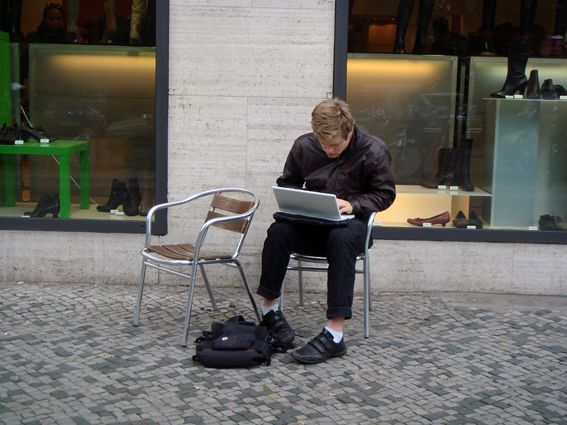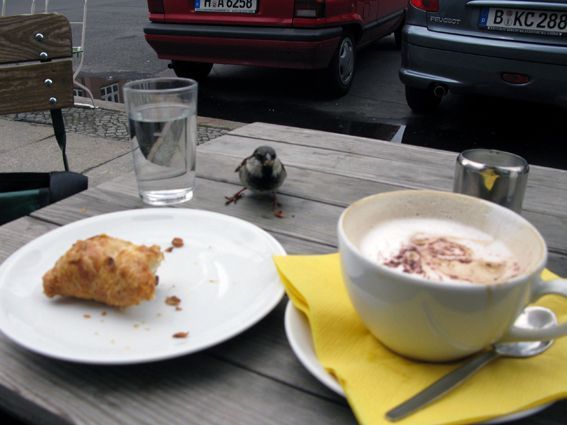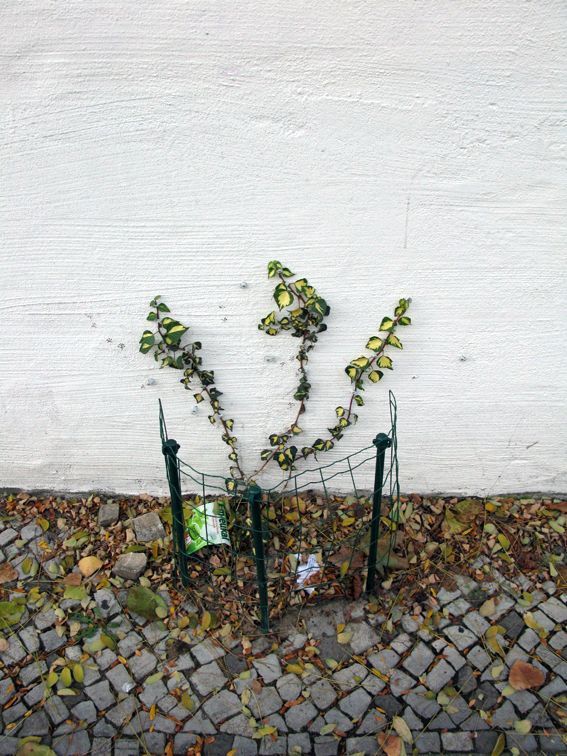Matthias Reichelt
Reality bites
Auf meinen Fahrradfahrten durch Berlin sowie auf Reisen per Zug durch die Republik habe ich immer meine Digitalkamera dabei und halte fest, was mir wert ist, erinnert zu werden. Bilder von mir meist völlig unbekannten Menschen, aber häufiger Situationen, die eine interessante Architektur oder eine bemerkenswerte Setzung und Anordnung von Zeichen erkennen lassen. Es sind Szenen und Situationen, die vielen kaum auffallen dürften, aber bei mir das Dickicht der medialen Abschottung mühelos durchdringen und Aufmerksamkeit einfordern. Während Roland Barthes in seinem Essay über die „helle Kammer“ untersucht, was auf irgendeinem Photo etwas in ihm zum „Klingeln“ bringt, muss ich mich fragen, weshalb mir ganz bestimmte, von anderen keines Blickes gewürdigte Szenen, Anordnungen, Strukturen etc. auffallen und in mir etwas zum „Klingeln“ bringen. Es geht hier also um Wahrnehmung, um Fokussierung und das Setzen des Rahmens bez. des Ausschnitts, mit dem ich meinen Wahrnehmungsfokus in das Bild überführen möchte. In diesem Sinne sind die hier gezeigten Bilder „persönliche Ansichten“ zum einen und doch gleichzeitig eine bedingte Fixierung dessen, was wir Wirklichkeit nennen. Bedingt insofern, als dass ich durch meine Inszenierung und das Ins-Bild-Setzen unterstreiche, was für mich im Fokus steht und erinnerungswürdig ist.
Es sind visuelle „Fait divers“, die allerdings in keiner Zeitung auftauchen würden, da sie kaum ein Redakteur einer Meldung wert erachten würde. In Reihung gesetzt ergeben die Bilder für mich eine Ansammlung von Reality Bites, kleine und vielleicht auch kurzlebige Situationen im Sozialen, die aber auch einen Zustand eines größeren Kontextes erahnen lassen. Nimmt man die „Realität“ als Subjekt, so steckt in „Reality Bites“ nicht nur der Begriff einer kleinstmöglichen digitalen Speichereinheit (bit), sondern der Satz: Realität beißt. Als ob die Realität um meine Aufmerksamkeit buhlte und ich sie dann im Ergebnis würdige, indem ich sie mit meiner Digitalkamera festhalte. Unter dem Strich sind es meine persönlichen Ansichten vom Mikrokosmos einer Gesellschaft.
Mich interessiert immer ein sehr subjektiver Blick auf Gesellschaft, auf den Stand des Systems. Dabei finde ich Motive im öffentlichen Raum, die mir ebenso interessant zu sein scheinen wie die Innenansicht eines privaten Kosmos. Zeichen im öffentlichen Raum sind ja ebenso Indizien für private Verhältnisse, Omnipotenz, oder Verdrängung von Schwäche wie z.B. bei dem Eigentümer – wahrscheinlich kein Gewinner – des in der Leipziger Straße in Berlin fotografierten SUV mit besonders hohen Reifen, der den Fahrer gegenüber allen anderen im Straßenverkehr erhöht. Wahrscheinlich besteht die Hoffnung, dass sich dies auch auf andere gesellschaftliche Sphären erweitern ließe.
Der Schilderwald ist auch ein gefundenes Motiv, das ironisch den Regulierungswahn ad absurdum führt, während zur selben Zeit eine Umverteilung von unten nach oben vorangetrieben wird und große Teile der Gesellschaft in prekäre Verhältnisse gezwungen werden.
Klaus-Rüdiger Landowsky, einer der politisch Hauptverantwortlichen des Berliner Banken-Skandals, hatte immer einen Sitz im Lottoausschuss und galt als großer Förderer der zeitgenössischen Kunst. 2006 konnte ich ihn ganz alleine auf dem Art Forum beobachten. Niemand dieses opportunistischen Kunstsystems, das Landowsky groß gehuldigt hatte, nahm mehr Notiz von ihm oder wollte mit ihm gesehen werden. Aber der Kunstbetrieb hatte einen anderen Helden, der ebenfalls die Förderung von Landowsky genossen hatte und es als Autodidakt zum Kurator ins MoMA und auf das Cover einer Zeitungsbeilage geschafft hatte. Irgendwie erinnerte mich das Konterfei auf dem Magazin an Mussolini.
Matthias Reichelt
Matthias Reichelt, geboren 1955, lebt als freier Autor, Kunstkritiker, Herausgeber und Kurator in Berlin.
On my tours with bike through Berlin as well as on my travels through the German republic by train I always take my digital camera with me to shoot whatever I find worth to be remembered: Images with people that are mostly unknown to me and often situations that show an interesting architecture or a remarkable order of signs and symbols. They focus situations and scenes that would probably be not recognized by others. They successfully permeate the coppice of my multimedia-based sealing off and ask for my attention. Roland Barthes examined in his last essay „Camera Lucida“ the „bright room“ to find out what an image must have to make something sound in his mind. In a different way I have to ask myself what scenes and situations, orders and structures often ignored by other people make something „sound“ in me.
I am referring to perception, focussing and setting the frame and choosing the section for my image to transfer my focus of perception into the image. In this sense I call my images on one hand „personal views“ and on the other hand they are somehow a fixation of what we call reality. I use the word somehow since through my personal setting the frame is emphasizing my personal focus. They are visual „fait divers“, that would never appear in a newspaper, since no editor would find them worth to be published. Set in row as a series, the images are a collection of reality bites, small and ephemeral situations in a social context, which make you sense the real condition of a wider context. If you take reality as a subject reality bites not only means the smallest unit of digital memory (bit) but the sentence: reality bites. As if the reality is striving after my attention and succeeds in receiving my recognition and causing me to document it with my digital camera. After all the images express my personal view on the microcosmic of society.
I am always interested in a subjective view on society on the state of society. With this focus I find motives in public space, I find as interesting as introspective of a private cosmos. Signs and symbols in public space are somehow evidence for private conditions. Omnipotence or displacement of social deprived as for instance the owner of the sports utility vehicle (SUV) with extremely big tires seen in the Leipziger Straße in Berlin. His high car, almost a tank, allows him to be in a higher position than all the other in traffic. The car owner – assumable not a winner – probably has the illusion that this could be true for other spheres in society?
The jungle of traffic signs is a found motive, making clear the absurd delusion to administer as much as possible while at the same time redistribution from the bottom to the top has been taken place pushing big parts of society in a precarious situation.
Klaus-Rüdiger Landowsky one of the main responsible of the Berlin bank scandal had always had a seat on the board of the lottery society and was therefore recognized as one of the big supporters for contemporary art in Berlin. In 2006 I could watch him walking the art forum totally lonesome. Nobody of this opportunistic art system, that had praised him before all the time, wanted to be seen with him anymore. But the art had its new hero who had been supported by Landowsky too and made it as a self-taught curator into the MoMA and on the cover of a supplement of a newspaper. Somehow his head on the cover reminded me of Mussolini.
Matthias Reichelt
Matthias Reichelt, born 1955, lives as a free lance writer, art critic, editor and curator in Berlin.









